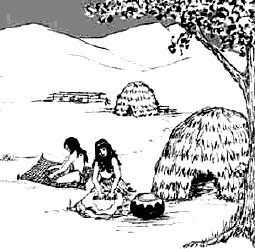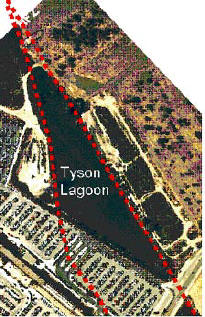|
Tule
Ponds at Tyson
HISTORY |
 |
|

Juan
Bautista Alvarado
12th Mexican Governor of California
|
Before William Tyson purchased this property in
the late 1800’s, this was part of a large Mexican land grant called
Ex-Mission San Jose. The land was given to Juan Bautista Alvarado and
Andres Pico in 1846 by the Mexican government. Their ownership was
nullified by the United States Land Commission in the late 1850’s
allowing people who were settling in the area to purchase land for $1.25
an acre. Prior to the Mexican land grab, the area was occupied by the
Spaniards, who referred to this as Mission San Jose.
The Ohlone Indians, who settled this area before
the Spaniards, used this marshy area to hunt and harvest the tules to
make homes, baskets, boats, and toys. The lagoon was probably larger and
connected to the marshy area that we now refer to as Stivers Lagoon. The
harvest of the tules during the fall would allow new homes and boats to
be made. The cattails were also harvested and used for food and weaving.
|

Tule
homes of Ohlone Indians from Dept of Interior, Indians of California, adapted from
U.S. Geological Survey
|
But before humans arrived in this area it was the
home of many animals including sabercats, dire wolves, sloths,
mastodons, bears, mammoths, prongbucks, and camels. These Pleistocene
prehistoric animals enjoyed a savannah type environment with weather
that is wetter than today. There is plant evidence that cattails,
willows, and oaks were abundant in the area as well as freshwater clams,
snail, and fishes. There is even evidence for the western toad, western
pond turtle and many of the same birds that are present today. Small
mammals like the white-foot mouse, vole, pocket mice, wood rats,
squirrels, gophers, and rabbits were also part of the Pleistocene
landscape. Whether this area during the Pleistocene, was a pond has not
been verified. However, since the Hayward fault system was active, it is
likely that these animals drank water from the Tyson Lagoon waters.
We know that the aquifers (water trapped as ground
water) were being created as geological processes trapped water in
permeable rock layers. These underground layers are collectively called
the Niles Cone. This water provides about 1/3 of the drinking water in
southern Alameda County.
|

Prongbuck is found in Pacific
Northwest today
|
Tyson Lagoon has been a site of fresh water for at
least the last 3700 years (Lienkaemper, et al, 2002). This sag pond
outlines the trace of the Hayward fault zone in this area. Looking at
brittle deformation and liquefaction features in trenches just north of
this area, Williams (1993) concluded there may have been 6-8 large
earthquakes during the last 2000 years. Lienkaemper, et al, with new
data concluded that since late 1300’s there were probably 4 large
earthquakes (of magnitude 6.8-7.0) In trenches in the South Pond they
found evidence of the 1868 earthquake. The earthquake destroyed most of
the Mission Adobe structure and devastated the homes of many of the
residents. Using detailed stratigraphy and carbon dating they arrived at
dates of 1730, 1630, and 1470 (±90 years) for the other earthquake
occurrences.
Detailed trenching in the south pond of Tyson
Lagoon by the U.S. Geological Survey have identified other earthquakes
that occurred in the past. They use data derived from trench logs,
radiocarbon, pollen, and detailed sedimentogical data. The trenching has
exposed typical pond sediments, including well-bedded deposits of silty
clay, interbedded with organic layers including shell hashes, and
slightly coarser, less organic silts to sandy silts. The composition and
structure of the deposits indicate a rapidly subsiding, shallow aquatic
environment that was subject to seasonal drying. Evidence of creeping
along the fault has been calculated with an average slip rate of 9±
2mm/yr (Leinkaemper and Borchardt, 1996)
|
Click on Picture to Enlarge

Niles Cone aquifers underneath
Fremont area
(adapted from Alameda County Water District).
|
From these studies other information on the environment can be derived.
The first nonnative pollen of Erodium cicutarium (red-stemmed filaree)
probably coincides with the arrival of Spanish in 1776 (Mensing and
Byrne, 1998). Sharp contact and layers of shells in sediments deeper
than 3.5 meters imply a larger body of standing water than present.
|

Trace of the Hayward Fault
(adapted from U.S. Geological Survey)
|
Tyson Lagoon today is about 100 meters wide, 300
meters long, and 2 meters deep. During the rainy season the surface area
doubles in size from 3 to 6 acres with a depth of 3 meters. It drains
approximately 40 percent of the Mowry Slough watershed. The lagoon is
classified as a permanent warm water sag pond (F1212) by the California
Department of Fish and Game. A sag pond is caused by percolation of
water along a fault. Tyson Lagoon lies on the Hayward fault.
A small patch of undeveloped land located just east
of the Fremont BART (Bay Area Rapid Transit) station, receives the run
off of approximately seven hundred acres. In the 1950’s it was modified
by Alameda County Public Works to serve as flood control for this
lowland area. In the 1960’s further modification was done because of the
addition of the BART station. In 1998, the lagoon was modified as a
constructed wetlands to help clean water run off before it goes into the
San Francisco Bay.
William Tyson
 William Tyson, one of eight children, was born in the
northwestern corner of England near Scotland, on December 5, 1820.
Although his family were mainly dairymen, William apprenticed as a
carpenter and became a house carpenter, joiner, and wagon-maker before
he was 21. William Tyson, one of eight children, was born in the
northwestern corner of England near Scotland, on December 5, 1820.
Although his family were mainly dairymen, William apprenticed as a
carpenter and became a house carpenter, joiner, and wagon-maker before
he was 21.
In the fall of 1841 he came to the
United States and settled in Columbus City, Iowa. It was his desire to
come to the land of his dreams. He worked as a wagon maker. In 1847 he
married Emmeline Morrison and moved to Port Louisa in Iowa. The gold
rush in California motivated Tyson to move with his wife, infant son,
and his brother-in-law, William Morrison, to seek his fortune. Mr. Tyson
lead the party of 19 wagons to the west. He acted as a scout and hunted
for game. It was remembered that he shot the first buffalo that people
in his party had ever eaten and killed five pheasants in one shot.
During the travel west their young
son died. The Tyson Family stopped at Hangtown (now known as
Placerville) in El Dorado County and opened a boarding house. The story
goes that after only three weeks Mr. Tyson and his brother-in-law bought
a gold claim for $300.00. They soon sold the claim to make quick money.
A series of unfortunate events convinced Tyson to go to Sacramento to
start a grocery store, which was not successful. He again opened a
boarding house. In 1850 he received a letter from his brother-in-law,
Perry Morrison from San Jose Valley. The letter convinced Tyson to move
to Mission San Jose, where he purchased a beautiful tract of land near
Alameda Creek. The land that he owned included wetlands as well as good
farmland. He brought his six sons and three daughters to this peaceful
place.
The Tyson’s celebrated their silver
anniversary in 1872. Compared to his earlier years of hardship, his life
was peaceful. He rarely left this area. He died in his home in Niles.
|